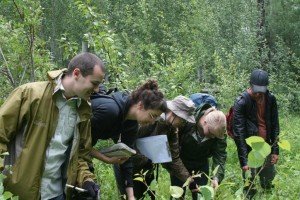We’re wrapping up this year’s fieldwork on our Rare Plants project! It’s been a great summer – 150 plots were sampled (50m x 50m each) in July and August across the Lower Athabasca region.
The project is a partnership between the ABMI, the EMCLA (Ecological Monitoring Committee for the Lower Athabasca), and the Neilsen Lab (U of A, Renewable Resources). The purpose is to figure out an efficient way to monitor for rare vascular plant species. ABMI does monitor vascular plants, but our protocol only allows searchers 20 minutes to look for plants using a systematic sample design, which means many hard-to-find and rare species could be missed. In northeastern Alberta (oil sands), the increased pace of development means that there is heightened concern that some plant species are at risk, and stakeholders want more detailed information on rare plant distribution than the ABMI can currently provide. So, we’re working together to find a way to monitor more species, but in a cost effective way.
The Nielsen Lab used a predictive modeling approach to identify areas with a high potential for rare plants (we looked for rare plants in places that had similar physical and vegetative characteristics to other places they have been found in Alberta). This strategy is more cost-effective than a purely random or systematic sampling design because rare plants are not distributed uniformly across the landscape. Plant Ecologist Shauna-Lee Chai consulted with rare plant experts across the province to design an efficient sample protocol that combined traditional meander searches with a more defined plot-based design. Our field techs include current ABMI employees, and botany graduate students (almost all of whom had worked for the ABMI before!).

Our July crews during training at Meanook Biological Research Station. From left to right: Neil Webster, Tess Grainger, Mel Patchell, Kelsey Bernard, and Tim Chipchar
Data collected in 2012 will be analyzed to describe patterns of vascular plant diversity across the region. Data entry and analysis is ongoing, but we have already secured funding for a second year of pilot fieldwork in the summer of 2013. In 2013, our aim will be to refine the protocols, increasing our sample size, and further investigating ways to make this program more efficient by integrating it with the core ABMI.
For more information on the EMCLA Rare Plants Project, contact Shauna-Lee Chai, Tim Chipchar, Amy Nixon, Susy Cote, or Scott Nielsen.

